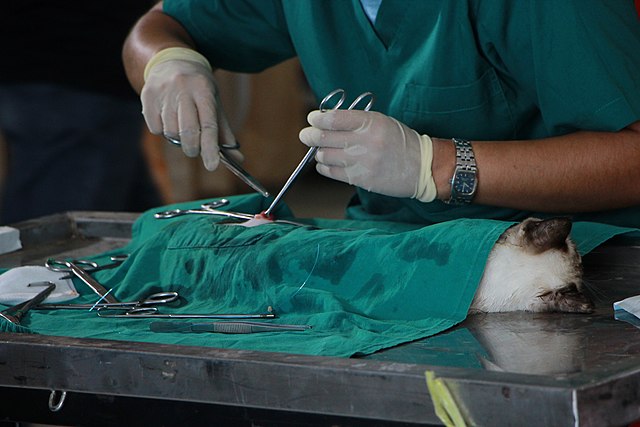Top Qs
Timeline
Chat
Perspective
Pet humanization
Applying care to pets that approaches human standards From Wikipedia, the free encyclopedia
Remove ads
Pet humanization is the practice in pet culture of treating companion animals with a level of care, attention, including luxury items. Pet humanization generally refers to treating pets like human family members.[1] The trend extends throughout history, including Ancient Greece, in which graves are found with sincere epitaphs to dogs, similar to human graves.[2]
This article needs additional citations for verification. (May 2025) |

To the extent that the treatment involves providing for the pet beyond their means of appreciation, it is considered to be a form of anthropomorphism though the limits of this remain an open topic. For example, anthropomorphism is more common among dog owners versus other pet owners in Romania.[3]
The current methodology of measuring pet humanization has been criticized, as markers like owners speaking to their pets, or putting jewellery on them are either widespread or could have other explanations.[citation needed]
Remove ads
History
Summarize
Perspective

In many ancient civilizations, people formed close bonds with animals, often using them for various purposes like hunting, protection, companionship, and animal worship. For example, some cats in ancient Egypt were considered sacred animals and were personified with the deity Bastet,[4] and provided with elaborate burials.[5] Dogs in religion hold various symbolic and cultural meanings across different religions and belief systems.
After looking at pre-Columbian Colima statues of dogs, a museum educator from the natural history museums of Los Angeles County, California argues that "the dogs of Mesoamerica had a complex relationship with humans and were often seen as equals that served important roles and functions in everyday life."[6]
In the 1st century, the Roman people were known for treating their animals "as family members" and constructing careful graves for them.[7]
In the mid-17th century, the phrase "dog is man's best friend" was coined by the Frederick the Great, King of Prussia.[citation needed] In the mid-20th century, the pet industry expanded, offering a wide range of products and services. This included the development of specialized pet foods,[8] veterinary medicine, grooming services, and even luxury items.[9]
Remove ads
Modern trends
Owners may prioritize premium or organic pet food, special diets and preparing homemade meals for their pets.[10] Pets receive regular check-ups, vaccinations and access to veterinary medicine that were previously uncommon. Owners may supply their pets with a wide variety of accessories such as clothing, collars, leashes and designer items. In addition, luxurious pet accommodations, such as elaborate pet beds or specialized animal furniture are now available. Pets may have birthdays celebrated with parties, special treats and social gatherings. Pet-friendly accommodations and travel arrangements are made for vacations or trips.[citation needed] Some pet owners create social media profiles for their pets, submitting facetious posts and interactions on their behalf.[11] In modern times, owners often form deep emotional bonds with their pets, considering them as a family member, seeking companionship and emotional support from them.
Remove ads
Human psychology

The psychology behind pet humanization involves understanding the motivations, emotions and behaviours that drive individuals to treat their pets as more than just animals and instead as valued members of the family or even as surrogate companions.[12]
Humans have a natural inclination to form emotional bonds with other living beings and pets often provide unconditional love, companionship, and a sense of belonging. This emotional connection can lead to the desire to provide the best possible care and attention for pets.[13]
Pet food industry

Pet humanization has a significant impact on the pet food industry, leading to changes in consumer behaviour, product offerings and marketing strategies. As pet owners increasingly view their pets as integral members of their families, they seek out higher quality and more specialized food options for their pet companions.[14] Pet owners who humanize their pets often seek pet foods made with high-quality, natural and wholesome ingredients. This includes "grain-free" pet food, which was investigated by the FDA as potentially causing dilated cardiomyopathy in dogs.[15] For dogs, food may include berries and other human-like foods, which can potentially negatively influence protein intake.[16]
Remove ads
Pet healthcare
Pet humanization has had an influence on the healthcare of pets, leading to changes in how pet owners approach veterinary care, especially among younger pet owners.[17]

The growth of pet insurance is considered a component of pet humanization, as it reflects the growing trend of treating pets as members of the family by financially supporting access to health care services similar to that of humans. In 2024, 6.4 million pets were insured in the United States, a 20.7% increase over the previous year.[18]
Remove ads
Pet bereavement
Pet bereavement and pet humanization are two concepts that are closely related and often intersect in the realm of human-pet relationships.[19][20][21]
Pet bereavement is the emotional response that pet owners experience when their pets pass away. It involves a range of emotions similar to the mourning process for a human loved one.[22][23][24][25]
Remove ads
See also
- Animal cognition – Intelligence of non-human animals
- Animal Rights – Rights belonging to animals
- Biophilia hypothesis – Idea that humans innately seek connections with the natural world
- Blessing of animals – Ceremonial blessing of companion, agricultural, or working animals
- Companion dog – Dog intended as a human companion
- Ethnobiology – Study of how living things are used by human cultures
- Human–animal communication – Verbal and non-verbal interspecies communication
- Human–canine bond – Interspecies relationship
- Human interaction with cats
- Interspecies friendship – Bond formed between animals of different species
- Man's best friend – Common phrase referring to domestic dogs
- Mutualism – Mutually beneficial interaction between species
- Symbiosis – Close, long-term biological interaction between distinct organisms (usually species)
Remove ads
Further reading
- Bartz, Jennifer A.; Tchalova, Kristina; Fenerci, Can (2016). "Reminders of Social Connection Can Attenuate Anthropomorphism: A Replication and Extension of Epley, Akalis, Waytz, and Cacioppo (2008)". Psychological Science. 27 (12): 1644–1650. doi:10.1177/0956797616668510. JSTOR 26170308. PMID 27777375.
- Borgi, Marta; Cirulli, Francesca (2016). "Pet Face: Mechanisms Underlying Human-Animal Relationships". Frontiers in Psychology. 7: 298. doi:10.3389/fpsyg.2016.00298. PMC 4782005. PMID 27014120.
- Epley, Nicholas; Waytz, Adam; Cacioppo, John T. (2007). "On seeing human: A three-factor theory of anthropomorphism". Psychological Review. 114 (4): 864–886. doi:10.1037/0033-295X.114.4.864. PMID 17907867.
- Epley, Nicholas; Waytz, Adam; Akalis, Scott; Cacioppo, John T. (2008). "When We Need a Human: Motivational Determinants of Anthropomorphism". Social Cognition. 26 (2): 143–155. doi:10.1521/soco.2008.26.2.143.
- Heider, Fritz; Simmel, Marianne (1944). "An Experimental Study of Apparent Behavior". The American Journal of Psychology. 57 (2): 243–259. doi:10.2307/1416950. JSTOR 1416950.
- Mourey, James A.; Olson, Jenny G.; Yoon, Carolyn (2017). "Products as Pals: Engaging with Anthropomorphic Products Mitigates the Effects of Social Exclusion". Journal of Consumer Research ucx038. doi:10.1093/jcr/ucx038. SSRN 2907436.
- Paul, Elizabeth S.; Moore, Anna; McAinsh, Pippa; Symonds, Emma; McCune, Sandra; Bradshaw, John W. S. (2014). "Sociality Motivation and Anthropomorphic Thinking about Pets". Anthrozoös. 27 (4): 499–512. doi:10.2752/175303714X14023922798192.
- Tam, Kim-Pong; Lee, Sau-Lai; Chao, Melody Manchi (2013). "Saving Mr. Nature: Anthropomorphism enhances connectedness to and protectiveness toward nature" (PDF). Journal of Experimental Social Psychology. 49 (3): 514–521. doi:10.1016/j.jesp.2013.02.001..
Remove ads
References
External links
Wikiwand - on
Seamless Wikipedia browsing. On steroids.
Remove ads
